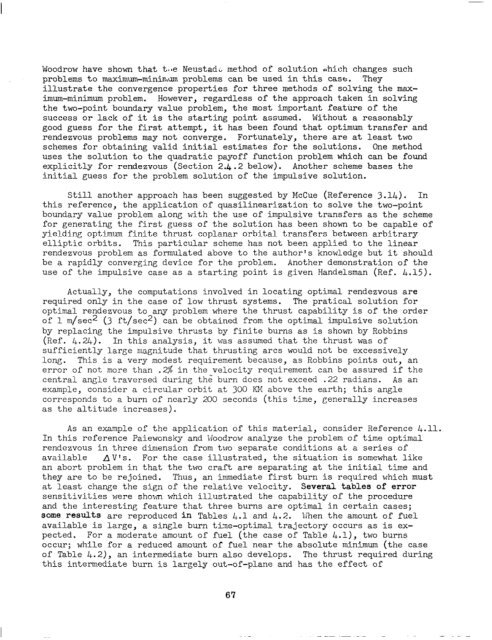guidance, flight mechanics and trajectory optimization
guidance, flight mechanics and trajectory optimization
guidance, flight mechanics and trajectory optimization
Create successful ePaper yourself
Turn your PDF publications into a flip-book with our unique Google optimized e-Paper software.
Woodrow have shown that t#le Neustad, method of solution cihich changes such<br />
problems to maximum-minimum problems can be used in this case. They<br />
illustrate the convergence properties for three methods of solving the max-<br />
imum-minimum problem. However, regardless of the approach taken in solving<br />
the two-point boundary value problem, the most important feature of the<br />
success or lack of it is the starting point assumed. Without a reasonably<br />
good guess for the first attempt, it has been found that optimum transfer <strong>and</strong><br />
rendezvous problems may not converge. Fortunately, there are at least two<br />
schemes for obtaining valid initial estimates for the solutions. One method<br />
uses the solution to the quadratic payoff function problem which can be found<br />
explicitly for rendezvous (Section 2.4.2 below). Another scheme bases the<br />
initial guess for the problem solution of the impulsive solution.<br />
Still another approach has been suggested by McCue (Reference 3.14). In<br />
this reference, the application of quasilinearization to solve the two-point<br />
boundary value problem along with the use of impulsive transfers as the scheme<br />
for generating the first guess of the solution has been shown to be capable of<br />
yielding optimum finite thrust coplanar orbital transfers between arbitrary<br />
elliptic orbits. This particular scheme has not been applied to the linear<br />
rendezvous problem as formulated above to the author's knowledge but it should<br />
be a rapidly converging device for the problem. Another demonstration of the<br />
use of the impulsive case as a starting point is given H<strong>and</strong>elsman (Ref. 4.15).<br />
Actually, the computations involved in locating optimal rendezvous are<br />
required only in the case of low thrust systems. The pratical solution for<br />
optimal rendezvous to any problem where the thrust capability is of the order<br />
of 1 m/sec2 (3 ft/ sec2) can be obtained from the optimal impulsive solution<br />
by replacing the impulsive thrusts by finite burns as is shown by Robbins<br />
(Ref. 4.24). In this analysis, it was assumed that the thrust was of<br />
sufficiently large magnitude that thrusting arcs would not be excessively<br />
long. This is a very modest requirement because, as Robbins points out, an<br />
error of not more than .2$ in the velocity requirement can be assured if the<br />
central angle traversed during the burn does not exceed .22 radians. As an<br />
example, consider a circular orbit at 300 KM above the earth; this angle<br />
corresponds to a burn of nearly 200 seconds (this time, generally increases<br />
as the altitude increases).<br />
As an example of the application of this material, consider Reference 4.11.<br />
In this reference Paiewonsky <strong>and</strong> Woodrow analyze the problem of time optimal<br />
rendezvous in three dimension from two separate conditions at a series of<br />
available AV'S. For the case illustrated, the situation is somewhat like<br />
an abort problem in that the two craft are separating at the initial time <strong>and</strong><br />
they are to be rejoined. Thus, an immediate first burn is required which must<br />
at least change the sign of the relative velocity. Several tables of error<br />
sensitivities were shown which illustrated the capability of the procedure<br />
<strong>and</strong> the interesting feature that three burns are optimal in certain cases;<br />
some resIiLtS are reproduced in Tables 4.1 <strong>and</strong> 4.2. When the amount of fuel<br />
available is large, a single burn tine-optimal <strong>trajectory</strong> occurs as is ex-<br />
pected. For a moderate amount of fuel (the case of Table 4.1), two burns<br />
occur; while for a reduced amount of fuel near the absolute minimum (the case<br />
of Table 4.2), an intermediate burn also develops. The thrust required during<br />
this intermediate burn is largely out-of-plane <strong>and</strong> has the effect of<br />
67
















